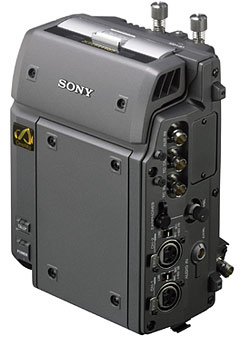Tiny Wonders for Big Eaters
You might not have noticed, but… while we've been getting fatter and slower, video recorders have been getting faster and smaller.
Within a span of about two years, we've been bombarded with a steady stream of digital recording devices, one smaller than the next, and with bigger and better capacities and specs by the month. But this wave of innovation didn't fall from the heavens; it actually evolved, in a manner of speakin', bit-by-bit. (Ain't that just precious.)
BITS IN YOUR BUCKET
There was no one historic day upon which pictures no longer were applied to videotape, not so far as Nellie the Neuron can remember. But it seemed like a pretty sudden transition—one day, a stack of digibetas and DV's, and the next, a pocket full of P2.
Bandwidth and bit-depth drove the economics of the first memory devices, from mediocre-quality outboard FireWire disc recorders to MPEG-2 transport streams squeezed onto SD cards. Higher compression rates meant higher capacities and longer record times; but the tradeoffs—noisy, soft images that were murder to edit—were hard to swallow. Even higher-quality media like SxS and P2 cards offered lower-bitrate, higher-compression options for the faint of heart.
Seems like it's been a decade-long race to the bottom… progressively smaller and smaller files, containing less and less of the original picture data. But, seriously, folks… how skinny can one file get? The results are kinda like sending a police sketch artist to record the Indy 500: you get the general idea, but somehow, the small details… and the excitement… are lost.
STORAGE MOVES OUT

Blackmagic Design Hyperdeck Shuttle
Now, everybody who's anybody knows that these days, you just can't be seen recording to your camera's onboard recorder. All the trendy kids on the block have a solid-state recorder mounted on their rigs… on a rail system, a battery bracket or even just with some Velcro. Kinda nutty to see the video output cabled up to a third-party device… but why not? For the most part, you can dial-in as much or as little compression as suits your taste. They're reliable; big capacities, usually; and you can often slap that thing right onto the edit system, and be choppin' away before the onboard cards are even halfway offloaded. And did I mention cheap? Not a trendy fellow myself, I nonetheless find it hard not to approve, big-time.
BRINGING HOME THE BACON (-BITS)
As my production pals know, I like my data like I like my cannoli… big and fat and incredibly pure. It's got to be as close to uncompressed as the laws of physics will allow. (And I've often been on the wrong side of that law.)
Now, in all fairness, some of the "electronic cinematography" crowd have begun to use heavy-duty, rack-mountable recorder systems, with monitoring systems and disk arrays and whatnot. But for those of us who actually leave the studio to make a living, 50 pounds and a long extension cord won't cut it; portable is everything, baby. And pushing big pictures into little boxes—well, that's real magic in my book. I'm a fan of the biggest and the fattest… the recorders that dare to gobble up picture data like it's a plate of yesterday's lasagna.

Sony SR-R4 SRMASTER
Got a light appetite? Feed your 1080p30 stream to Blackmagic Design's inexpensive HyperDeck recorders. Boy genius Grant Petty designed these babies to record no-compromise, uncompressed QuickTime files, with an input that runs at up to 3Gbps. Slap in a solid-state drive (SSD), and devour every bit.
Thinking of a more meaty signal? With Dual-Link inputs and uncompressed DPX recording, Convergent Design's Gemini launched last year as a big-bit-depth (4:4:4) SSD box, with planned firmware upgrades for two-channel stereo/3D as well as 2K cinema recording. Bon appétit!
But if belly-bustin' big-data is on your menu, get ready to mangia. Sony's SR-R1 and SR-R4 SRMASTER recorders swallow 3Gbps/Dual-Link, 4:4:4 bit depths, and stereo/3D; and the R4 records raw camera data in 4K, too. Does it all on flash memory cards installed in the box, selectable for writing speeds up to 5.5Gbps and capacities to 1TB. Mount one on your rig, and go crazy.
BIG RESULTS
It's taken half a century, but we've managed to flip a skinny-stream/fat-recorder scenario upside-down, with big ol' signals captured on tiny silicon wonders. That means that King Content, that merry old soul who pays our phoney-baloney salaries, arrives at his destination in all his splendid, high-resolution glory—
only to be compressed down small enough to stream to a 4-inch smartphone screen.
Go figure.
Mario Orazio is the pseudonym of a well-known television engineer who wishes to remain anonymous. E-mail him at morazio@nbmedia.com.
The professional video industry's #1 source for news, trends and product and tech information. Sign up below.
